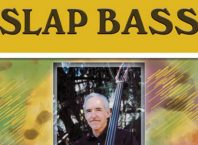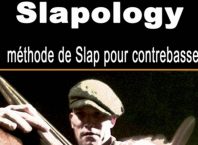A Slight Introduction (CD Included)
by Didi Beck

First I have to mention that I am extremely appreciative, and encourage any effort when I see people write about slap bass. There are not that many articles written about it (read about it here) and it’s very hard to find any relevant resources. I’ve been writing a book about slap bass history and techniques for almost eight years now and I realize how much work and time that kind of research requires.
Instead of focusing on obscure details and analyzing other people’s playing, Didi Beck decided to cover basic slap bass patterns commonly used in Rockabilly music, which the title of the book clearly implies Rockabilly Slapbass – A Slight Introduction. The main focus of this 112 page long book is slap bass technique of course, but it also covers the most common rockabilly bass lines. That makes it perfect for beginners that want to learn how to play upright bass in a rockabilly band.
Beck starts with basic music theory (note value, rests and note system) in order to help readers to follow the book. Seven photos (the other 14 photos shows Beck with his bass in various situations) were used to describe how to pull a string in order to make a pizzicato or slap sound and ten to describe proper left hand position (for classical and rockabilly music).
As far as slap goes, Didi explains how to play single, double, triple (triplet and gallop) and rumba pattern (he uses the same terminology used in the article Basic Slap Bass Patterns on this w-site*). In one rhythm exercise (page 73) he notated quadruple slap as well, but he didn’t name it.
I like that he explained these basic patterns first with open strings and than added actual bass lines to it. Each example is notated and has tablature, which makes it easier for bass players without any musical knowledge to follow. Almost every example from the book is also on the CD (48 total).
12 bar blues form is something that Beck in general uses to explain different bass lines and slap patterns. Walking bass lines that he covers are mostly based on arpeggios (major and minor triads, 6 and 7 chords) with some chromatic walk ups and walk downs. There are two exercises that are a bit more advanced (Page 69 and 70), but they still fit in the rockabilly style of playing. Another form that he briefly covered is Rhythm Changes in the swing section (page 84). This exercise is also the one that goes the highest on the fingerboard – till E (on the G string). All the other examples go maximum to D. Beck also explains root-five and shuffle bass lines.
A big part of the book is basic music theory. He explains C major scale, modes (more focused on the ones important for playing rockabilly – Ionian, Mixolydian, Aeolian), intervals and three and four note chords.
Didi wrote bass lines based on songs That’s All Right Mama, Rumble in Brighton**, Twenty Flight Rock and Stray Cat Strut (he calls it Typical Rockabilly style bass in C major***)
At the second part, he explains Tiger Army type of slap bass in two exercises (pages 79 and 80). I found that to be one of the more interesting parts of the book together with his 3/4 exercise called Youthful misdeed (page 85) and Rhythm Studies (pages 88 and 89).
At the end of the book, Beck wrote his biography, gave an overview of his equipment and a little description about bass as an instrument. He also gave his personal opinion on how different strings, pickups, and amps work for slap bass. Finally, he gives a list of his favorite bass websites and books for further research.
Something that I noticed that this book is missing are chords on top of the examples. Since the book is mostly for beginners, that might be a good addition and something that the publishers should consider adding to the second edition. Another thing that I don’t agree with is the notation of swing eight notes (shuffle for example). Beck calls it Triplet Rhythm and uses triplets with the rest in the middle to notate them, which makes it a little bit harder to read by my opinion. It’s widely accepted that swing eights are written like regular eight notes with the word ‘swing’ written above the bar to indicate that you should play them with a swing feel.
The book was published in two languages simultaneously (German and English) by German publishing company artist-ahead in 2009.
Rockabilly Slapbass – A Slight Introduction by Didi Beck has a very personal approach, so if you’re Didi Beck’s fan, beginner, or if you want to complete your knowledge about Rockabilly bass, this one is perfect for you!
You can purchase this book here.




[…] Hi Didi! Congratulations on your first book “Rockabilly Slapbass – A Slight Introduction“. How long did it take you to write […]